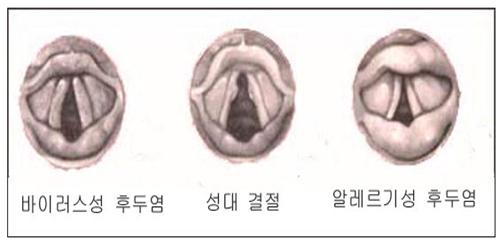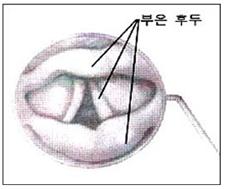급성 경련성 크루프(급성 경련성 후두염) Acute spasmodic croup (Acute spasmodic laryngitis)
| 급성 경련성 크루프(급성 경련성 후두염)의 원인 |

그림 87. 바이러스 후두염, 성대 결절, 알레르기성 후두염
출처- 소아가정간호 백과와 Used with permission from Schering Corporation Kenilworth, NJ 07033
- 후두에 염증이 생기면 후두염이 생긴다.
- 후두염이 급성으로 경련되면 크루프 증상이 생긴다.
- 후두염이 급성으로 경련해서 생기면 급성 경련성 후두염, 또는 경련성 크루프라고 한다.
- 급성 경련성 크루프는 밤중에 자다가 갑자기 생길 때가 더 많다.
- 자다가 갑자기 깨고 목이 쉬고 흡기 협착음이 생기고 경도 내지 중등도 호흡곤란이 생기는 것이 보통이다.
- 이 병을 앓을 때 고열은 나지 않는다.
- 잠잘 때 갑자기 급성 경련성 크루프 증상이 잠시 동안 생겼다가 아침에 일어나면 그 크루프 증상이 씻은 듯이 다 없어지는 것이 보통이다.
- 그러다가 그 다음 날 밤중에 전날 밤과 거의 비슷하게 갑자기 거의 같은 크루프 증상이 생길 수 있다.
- 이런 크루프가 며칠 동안 계속될 수 있다.
- 이 크루프는 1~3세 유아들에게 더 잘 생긴다.
- 원인은 아직 확실히 모른다.
- 바이러스 후두염이 원인이라 추정하기도 하고 알레르기로 유발되는 알레르기 후두염이라고 추정하기도 한다.
- 알레르기 체질(아토피 체질)을 가진 아이들이나 신경질적인 유아들에게 더 잘 생기고 알레르기성 질환의 병력이 있는 친 부모 형제들의 다른 형제들에게 급성 경련성 후두염이 더 잘 생긴다.
| 급성 경련성 크루프(급성 경련성 후두염)의 증상 징후 |
- 급성 경련성 크루프의 증상 징후는 다른 종류의 크루프의 증상 징후보다 훨씬 경미하다.
- 이 병이 발생되기 1~2일 전에 콧물이 나고, 목이 약간 쉬는 증상 징후가 있는 것이 보통이다.
- 크루프가 한 밤 중에 자다가 갑자기 생기고 그로 인해 호흡곤란과 흡기 협착음이 생기면서 물개 짖는 소리처럼 컹컹 기침을 심하게 할 수 있다.
- 심할 때는, 숨 쉴 때 가슴의 늑골 사이에 있는 늑골 근육들이 흉강 속으로 빨려 들어갔다 나왔다 할 수 있으나 급성 바이러스 후두염이나 급성 후두 기관 기관지염을 앓을 때처럼 크루프 증상 징후가 훨씬 경미한 것이 보통이다.
- 열이 전혀 나지 않거나 때로는 미열이 날 수 있고 목이 조금 쉬고 기침을 조금 할 수 있다.
- 이런 증상 징후가 불과 몇 시간 동안 지속되다가 다 나은 것처럼 건강하다가 그 다음 날 낮에는 목이 조금 쉬거나 기침을 조금 할 수 있고 그 날 밤에 갑자기 전날 밤과 같이 크루프 증상이 다시 생길 수 있다.
- 이런 증상 징후가 2~3일간 반복되다가 저절로 나을 수 있다.

그림 88. 알레르기로 생긴 후두염과 부은 성대
출처-소아가정간호백과와 Used with permission from Schering Corporation, Kenilworth, NJ 07033 USA
| 급성 경련성 크루프(급성 경련성 후두염)의 진단 |
- 병력, 증상 징후, 진찰소견 등을 종합해 쉽게 진단할 수 있다.
- 이 병은 다시 재발되는 경향이 있다.
- 그 아이에게 거의 같은 크루프의 증상 징후가 과거에 있었던 병력이 있으면 진단하기가 더 쉽다.
- 기관지 천식, 아토피 피부염, 알레르기 비염 등의 과거나 현재의 병력이 있거나 알레르기 체질을 가진 아이들은 이 병에 더 잘 걸린다.
- 그래서 과거 현재의 급성 경련 크루프의 병력이 있으면 진단하는데 가치가 있다.
| 급성 경련성 크루프(급성 경련성 후두염)의 치료 |
- 이 병을 경미하게 앓을 때는 의사의 지시에 따라 집에서 부모가 치료할 수 있다.
- 그러나 병원 응급실에서 치료받아야 할 때가 더 많다.
- 19세기부터 찬 바깥 공기 호흡 치료를 하거나 찬 수증기 흡입 치료를 하기도 했다.
- 급성 경련 크루프(급성 경련 후두염)를 찬 수증기 흡입 치료를 하면 치료 효과가 있으나 다른 종류의 크루프 치료에는 큰 효과는 없다는 것이 최근 연구 결과이다(출처-Pediatric News, March 2004).
- 춥지 않게 담요로 환아를 폭신 싼 후 찬 바깥 공기를 잠시 동안 숨 쉬게 하면 증상이 금방 좋아질 수 있다. 날씨가 추워 집밖으로 데리고 나가기가 곤란할 때는 창문을 열고 연 창문으로 들어오는 바깥 찬 공기를 숨 쉬게 해도 된다.
- 실내 습도를 60% 정도로 유지한다. 항생제 치료는 이 병에 효력이 없다.
- 호흡곤란의 정도와 협착음의 중증도, 치료 결과 등에 따라 치료를 다르게 할 수 있다. 다음과 같이 여러 가지 방법으로 치료한다.
- 응급실에서는, Epinephrine, 분무 요법으로 치료한다. Epinephrine 분무 요법 치료의 결과에 따라 1~2시간 후 반복 할 수 있다. 치료 결과가 좋으면 치료 후 3시간 동안 관찰했다가 계속 호전되면 집으로 퇴원하는 식으로 치료한다.
- 코르티코스테로이드제로 치료하면 효과가 가장 좋다고 한다. 경구용 Dexamethasone (Decadron)제나 경구용 프레드니손제로 치료하든지 Budsonide 분무로 치료할 수 있다.
- 드물게는 코르티코스테로이드제 근육 주사로도 치료한다.
- 숨 쉴 때 협착음을 내고 개 짓는 소리 같이 컹컹 소리를 내고 호흡곤란이 있으면 기도 내 이물, 급성 후두개염 또는 바이러스 후두염으로 생긴 크루프와 감별 진단해야한다.
Acute spasmodic croup (Acute spasmodic laryngitis) 급성 경련성 크루프(급성 경련성 후두염)
Causes of acute spasmodic
croup (acute spasmodic laryngitis)

Figure 87. Viral laryngitis, vocal cord nodules, allergic laryngitis Source- Pediatric Home Care Encyclopedia Used with permission from Schering Corporation Kenilworth, NJ 07033
• Inflammation of the larynx leads to laryngitis.
• An acute convulsion of laryngitis causes symptoms of croup.
• When laryngitis is caused by acute spasmodic, it is called acute spasmodic laryngitis, or convulsive croup.
• Acute spasmodic croup is more common when you sleep in the middle of the night and suddenly develop.
• During sleep, it is common to wake up suddenly, have a sore throat, develop inspiratory strictures, and develop mild to moderate difficulty breathing.
• I don’t get a high fever when I have this disease.
• Suddenly acute spasmodic croup symptoms occur for a while while sleeping, and then when you wake up in the morning, the symptoms usually disappear as if washed away. • Then the next night, you may suddenly develop almost the same croup symptoms in the middle of the night, almost the same as the previous night.
• These croups can last for several days.
• This croup is more prone to infants aged 1 to 3 years.
• The cause is still unknown.
• Some assume that it is caused by viral laryngitis, and some assume that it is allergic laryngitis caused by allergies.
• Acute spasmodic laryngitis is more prevalent in children with an allergic predisposition (atopic predisposition) or in neurotic infants and in other siblings of parental siblings who have a history of allergic disease.
Symptoms signs of acute spasmodic croup (acute spasmodic laryngitis)
• Symptoms of acute spasmodic croup are much milder than those of other types of croup. • One to two days before the onset of the disease, symptoms of a runny nose and a slight sore throat are usually present.
• Croups suddenly occur during the night of sleep, resulting in shortness of breath and inhalation strictures, which can cause severe coughing, like the sound of a seal barking.
• In severe cases, the rib muscles between the ribs of the chest may be sucked into and out of the chest cavity when breathing, but the symptoms of Croup are usually much milder, such as with acute viral laryngitis or acute laryngeal bronchitis.
• You have no fever at all, or you may have a mild fever sometimes, a little sore throat and a little coughing.
• Symptoms of these symptoms last only a few hours and are healthy, as if they are all well, then the next day you may have a little sore throat or a little coughing, and that night you may suddenly return to Croup as you did the previous night
• Symptoms of these symptoms may recur for 2-3 days and then heal on their own.

Figure 88. Allergic laryngitis and swollen vocal cords Source-Pediatric Family Nursing Encyclopedia and Used with permission from Schering Corporation, Kenilworth, NJ 07033 USA
Diagnosis of acute spasmodic croup (acute spasmodic laryngitis)
• It can be easily diagnosed by synthesizing medical history, symptom signs, and examination findings.
• The disease tends to recur again.
• It is easier to diagnose if the child has a history of past symptoms of almost the same Croup symptoms.
• Children with a history of or allergic predisposition, such as bronchial asthma, atopic dermatitis, and allergic rhinitis, are more susceptible to this disease.
• So, if you have a history of past and present acute seizure croup, it is worth diagnosing.
Treatment of acute spasmodic croup
• Mild illness can be treated by parents at home as directed by a doctor.
• However, there are more times when you need to be treated in a hospital emergency room.
• Since the 19th century, cold outside air breathing therapy or cold vapor inhalation therapy has been performed.
• Steam inhalation treatment with acute cramping (acute spasmodic laryngitis) has a therapeutic effect, but a recent study has shown that it has no significant effect on other types of croup treatment (Source-Pediatric News, March 2004).
• If you wrap your child with a blanket so that it is not cold and breathe in the cold outside air for a while, symptoms can improve quickly. When the weather is cold and it is difficult to take it out of the house, you can open a window and breathe the cold outside air coming in through the opened window.
• Keep indoor humidity at around 60%. Antibiotic treatment has no effect on this disease.
• Treatment can be done differently depending on the degree of dyspnea, the severity of the stenosis, and the treatment result. There are several methods of treatment as follows.
• In the emergency room, treat with Epinephrine, spray therapy. Epinephrine spray therapy can be repeated after 1 to 2 hours depending on the result of treatment.
If the treatment result is good, observe it for 3 hours after treatment, and if it continues to improve, treat it by discharging to the hospital.
• Treatment with corticosteroids is said to work best. It can be treated with oral Dexamethasone (Decadron) or oral prednisone, or with Budesonide spray.
• Rarely, it is treated with intramuscular injections of corticosteroids.
• If you have a stricture sound when you breathe, make a squeaky noise like a dog’s whisper, and have difficulty breathing, you should be diagnosed with a foreign body in the airway, acute epiglottis, or a croup caused by viral laryngitis.
출처 및 참조 문헌 Sources and references
- NelsonTextbook of Pediatrics 22ND Ed
- The Harriet Lane Handbook 22ND Ed
- Growth and development of the children
- Red Book 32nd Ed 2021-2024
- Neonatal Resuscitation, American Academy Pediatrics
-
Childhood Emergencies in the Office, Hospital and Community, American Academy of Pediatrics
-
Emergency Medical Service for Children, By Ross Lab. May 1989. p.10
-
Emergency care, Harvey grant, and Robert Murray
-
Emergency Care Transportation of Sick and Injured American Academy of Orthopaedic Surgeons
-
Emergency Pediatrics A Guide to Ambulatory Care, Roger M. Barkin, Peter Rosen
-
Immediate care of the acutely ill and injured, Hugh E. Stephenson, Jr
-
The Critically Ill Child, Diagnosis and Management, Edited by Clement A. Smith
-
Emergency Medical Services for Children: The Role of the Primary Care Provider, America Academy of Pediatrics
-
Quick Reference To Pediatric Emergencies, Delmer J. Pascoe, M.D., Moses Grossman, M.D. with 26 contributors
-
Manual of Emergency Care
-
응급환자관리 정담미디어
-
소아가정간호백과–부모도 반의사가 되어야 한다, 이상원
-
Neonatal Resuscitation American heart Association
-
Neonatology Jeffrey J.Pomerance, C. Joan Richardson
-
Pediatric Resuscitation Pediatric Clinics of North America, Stephen M. Schexnayder, M.D.
-
Pediatric Critical Care, Pediatric Clinics of North America, James P. Orlowski, M.D.
-
Preparation for Birth. Beverly Savage and Dianna Smith
-
Nelson Textbook of Pediatrics 14th ed. Beherman,
-
The Johns Hopkins Hospital, The Harriet Lane Handbook, 18th edition
-
Red book 29th edition 2012
-
Nelson Text Book of Pediatrics 19th Edition
-
Infectious disease of children, Saul Krugman, Samuel L Katz, Ann A. Gershon, Catherine Wilfert
-
The Harriet Lane Handbook 19th Edition
-
소아과학 대한교과서
-
제1권 소아청소년 응급의료 참조문헌과 출처
-
Other
Copyright ⓒ 2015 John Sangwon Lee, MD., FAAP
“부모도 반의사가 되어야 한다”-내용은 여러분들의 의사로부터 얻은 정보와 진료를 대신할 수 없습니다.
“The information contained in this publication should not be used as a substitute for the medical care and advice of your doctor. There may be variations in treatment that your doctor may recommend based on individual facts and circumstances. “Parental education is the best medicine.”